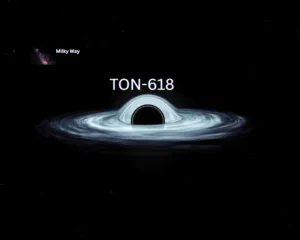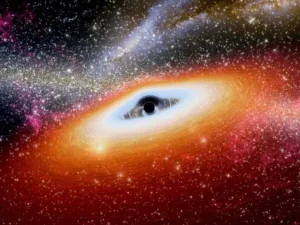Black holes are one of the most mysterious objects in the universe, but the largest black hole in the universe is on a completely different level. We are talking about a cosmic structure that is so massive that it could challenge any imagination. Today, we will talk about the story of the largest black hole discovered so far and how it continues to amaze scientists and space lovers alike. Before diving in, let’s take a look at a few quick facts about ton 618.
Quick Facts about TON 618:
- TON 618 is one of the biggest black holes known in the universe.
- It is a hyper-luminous quasar located about 10.37 billion light-years away.
- Its mass is estimated to be around 66 billion times that of our Sun.
- TON 618 shines with immense energy, fueled by matter falling into it.
- This black hole helps scientists understand how massive black holes grow.
What Is a Black Hole?

Before we discuss the biggest black hole, it is important to understand what are black holes. Black holes are the regions of space where gravity is so strong that even light cannot escape. They form when massive stars collapse in on another star at the end of their life cycles. The gravitational pull of a black hole is so strong that it destroys the building blocks of space and time.
Scientists have long been interested in black holes because they represent the extreme limits of physics. They provide a unique insight into how gravity works and how massive objects establish the universe. But not all black holes are the same. Some are tiny, while others are really huge.
Introduction to TON 618
When we talk about the biggest black holes in the universe, TON 618 stands out due to its massive size and gravitational power. Astronomers discovered it by studying particles called quasars, extremely bright objects created by black holes that devour matter. When TON 618 breaks down to gas and dust, it shines brilliantly. This brilliance allows us to see it from across the universe.
The mass of TON 618 was calculated using data from its quasar activity, making it the heaviest black hole known. Imagine a black hole so immense that it could instantly swallow an entire solar system. That black hole is TON 618.
Discovery of TON 618 ?

TON 618 was discovered in the 1950s when astronomers studied bright quasars. The light emitted by this quasar provided the clues about the size of its black hole. By analyzing the light and matter around it, scientists determined that TON 618 is the largest black hole known.
To measure the size of a black hole, scientists observe its effects on surrounding matter. The largest black holes in the universe, such as TON 618, have a powerful gravitational pull. This pull affects the surrounding gas and dust, causing it to emit light. By studying these emissions, astronomers estimate the black hole’s mass.
Importance of TON 618
Supermassive black holes, including TON 618, play a very important role in galaxy formation. They act as a supporting structure, exerting an impact on the motion of stars and gas within the galaxies. Without such black holes, galaxies could not exist in their current form. Therefore, studying the largest black holes in the universe helps us to understand the universe more deeply.
TON 618 provides valuable information about the limits of space. By investigating the universe’s largest black holes, scientists can test theories about gravity and black hole formation. Each discovery about TON 618 helps to expand our knowledge about the universe’s most extreme objects.
Role of Biggest Black Holes in Galaxy Formation

Here are details of why the largest black hole in the universe is important:
1. Gravitational force
TON 618’s powerful gravity affects the motion of stars and gas in its galaxy.
2. Galactic core
It is located at the center of its galaxy, serving as a focal point for galaxy formation.
3. Matter Consumption
The black hole consumes gas and dust, thereby releasing energy and facilitating its expansion.
The largest black hole in the universe is currently TON 618, but scientists are always looking for bigger black holes. The universe is vast and largely unknown, which means even bigger black holes may exist in distant galaxies. As our technology improves, we may soon find black holes that are even bigger than TON 618 in size.
Size of the Biggest Black Hole in the Universe
You may be interested in how astronomers measure the largest black hole in the universe. They rely on the behavior of light and matter around a black hole. When matter is pulled into a black hole, it heats up and emits radiation that we can see with telescopes. By studying this radiation, scientists can estimate the size of a black hole.
Scientists use a method called the “Schwarzschild radius.” It helps to calculate the event horizon. This is the point beyond which nothing can escape a black hole. In the case of TON 618, its event horizon is so massive that it stretches across light years.
Table: Schwarzschild Radius of Black Holes
| Black Hole Type | Approximate Mass (in Suns) | Schwarzschild Radius (in kilometers) |
|---|---|---|
| Stellar Black Hole | 10-100 | 30-300 |
| Supermassive Black Hole | Millions-Billions | Millions of kilometers |
| TON 618 (Biggest Black Hole in the Universe) | 66 billion | Over 1 trillion |
The largest black hole in the universe is fascinating. However, reaching it with our current technology would be impossible. TON 618 is located more than 10 billion light years away. It would take us billions of years to get there even if we traveled at the speed of light. We won’t be able to go there anytime soon. However, studying it from far away will help us understand the universe far beyond our solar system.
Final Thoughts
TON 618, is the universe’s largest black hole, and is a reminder of the incredible mysteries that lie beyond our reach. It serves as a testimony to the inexhaustible power and complexity of the cosmos. As we continue to explore the universe, who knows what other cosmic giants are waiting to be discovered?
Recommended Reads for Curious Minds
- Basic Physics: A Self-Teaching Guide by Karl F. Kuhn
- Black Holes and Time Warps by Kip S. Thorne
- Astrophysics for People in a Hurry by Neil deGrasse Tyson
Frequently Asked Questions
Ton 618 was discovered in the 1950s during radio surveys of distant quasars. It was identified as a massive black hole through its bright quasar emissions.
Ton 618 is a supermassive black hole located in a distant, faint galaxy. Although the exact galaxy is not well studied, Ton 618 is known to be part of a galaxy far away in the universe.
Ton 618 is a supermassive black hole located in a distant, faint galaxy. Although the exact galaxy is not well studied, Ton 618 is known to be part of a galaxy far away in the universe.
Ton 618’s diameter is about 195 billion kilometers. This massive size comes from its event horizon, the boundary beyond which nothing can escape its gravity.
Currently, Ton 618 is one of the largest known black holes. Scientists have not confirmed any black hole bigger than Ton 618 yet. However, space is vast, and new discoveries may change this in the future.
The gas cloud that helped form the TON 618 black hole is known as a quasar nebula—a massive, dense cloud of gas and dust fueling the black hole’s growth during its early stages.
TON 618 has a very strong gravity, but to find out how strong it is in newtons, you need to know how far away you are from the black hole. Close to it, the gravity is billions of times stronger than Earth’s, pulling everything in with great force.





2 Comments
Hi, yes this post is in fact pleasant and I have learned lot of things from it on the topic of blogging.
thanks.
Thanks a lot! I’m really glad the post helped you learn something new about blogging.